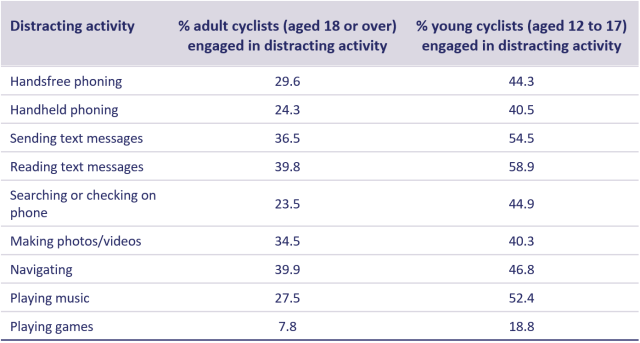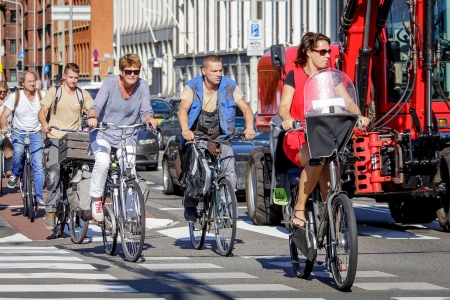Below you will find the list of references that are used in this fact sheet; all sources can be consulted or retrieved. Via Publications you can find more literature on the subject of road safety.
[1]. Aarts, L.T., Broek, L.J. van den, Oude Mulders, J., Decae, R.J., et al. (2022). Achtergronden bij De Staat van de Verkeersveiligheid 2022. De jaarlijkse monitor [Backgrounds of the State of Road Safety 2022. The annual monitor]. R-2022-10A [Summary in English]. SWOV, Den Haag.
[2]. Aarts, L.T., Wijlhuizen, G.J., Gebhard, S.E., Goldenbeld, C., et al. (2021). Achtergronden bij De Staat van de Verkeersveiligheid 2021. De jaarlijkse monitor [Backgrounds of the State of Road Safety 2021. The annual monitor]. R-2021-21A [Summary in English]. SWOV, Den Haag.
[3]. Bos, N.M., Houwing, S. & Stipdonk, H.L. (2016). Ernstig verkeersgewonden 2015. Schatting van het aantal ernstig verkeersgewonden in 2015 [Serious road injuries 2015. Estimate of the number of serious road injuries in 2015]. R-2016-13 [Summary in English]. SWOV, Den Haag.
[4]. Krul, I., Valkenberg, H., Asscherman, S., Stam, C., et al. (2022). Fietsongevallen en snor-/bromfietsongevallen in Nederland - SEH-bezoeken: inzicht in oorzaken, gevolgen en risicogroepen. Rapport 934. VeiligheidNL.
[5]. Schepers, P., Agerholm, N., Amoros, E., Benington, R., et al. (2015). An international review of the frequency of single-bicycle crashes (SBCs) and their relation to bicycle modal share. In: Injury Prevention, vol. 21, nr. E1, p. e138-e143.
[6]. Utriainen, R., O’Hern, S. & Pöllänen, M. (2022). Review on single-bicycle crashes in the recent scientific literature. In: Transport Reviews, p. 1-19.
[7]. Algurén, B. & Rizzi, M. (2022). In-depth understanding of single bicycle crashes in Sweden - Crash characteristics, injury types and health outcomes differentiated by gender and age-groups. In: Journal of Transport & Health, vol. 24, p. 101320.
[8]. Boele-Vos, M.J., Duijvenvoorde, K. van, Doumen, M.J.A., Duivenvoorden, C.W.A.E., et al. (2017). Crashes involving cyclists aged 50 and over in the Netherlands: An in-depth study. In: Accident Analysis & Prevention, vol. 105, p. 4-10.
[9]. Utriainen, R. (2020). Characteristics of commuters’ single-bicycle crashes. In: Insurance Data. Safety vol. 6, p. 13.
[10]. Hosseinpour, M., Kidholm Osmann Madsen, T., Vingaard Olesen, A. & Lahrmann, H. (2021). An in-depth analysis of self-reported cycling injuries in single and multiparty bicycle crashes in Denmark. In: Journal of Safety Research, vol. 77, p. 114-124.
[11]. Petegem, J.H. van, Schepers, P. & Wijlhuizen, G.J. (2021). The safety of physically separated cycle tracks compared to marked cycle lanes and mixed traffic conditions in Amsterdam. In: European Journal of Transport and Infrastructure Research, vol. 21, nr. 3, p. 19-37.
[12]. Schepers, J.P., Kroeze, P.A., Sweers, W. & Wüst, J.C. (2011). Road factors and bicycle–motor vehicle crashes at unsignalized priority intersections. In: Accident Analysis & Prevention, vol. 43, nr. 3, p. 853-861.
[13]. Prati, G., Marín Puchades, V., Angelis, M. de, Fraboni, F., et al. (2018). Factors contributing to bicycle–motorised vehicle collisions: a systematic literature review. In: Transport Reviews, vol. 38, nr. 2, p. 184-208.
[14]. Kovácsová, N., Winter, J.C.F. de, Schwab, A.L., Christoph, M., et al. (2016). Riding performance on a conventional bicycle and a pedelec in low speed exercises: Objective and subjective evaluation of middle-aged and older persons. In: Transportation Research Part F: Traffic Psychology and Behaviour, vol. 42, p. 28-43.
[15]. Schwab, A.L. & Meijaard, J.P. (2013). A review on bicycle dynamics and rider control. In: Vehicle System Dynamics, vol. 51, nr. 7, p. 1059-1090.
[16]. Schepers, J.P., Weijermars, W.A.M., Boele, M.J., Dijkstra, A., et al. (2020). Oudere fietsers. Ongevallen met oudere fietsers en factoren die daarbij een rol spelen [Older cyclists. Crashes involving older cyclists and contributory factors]. R-2020-22A [Summary in English]. SWOV, Den Haag.
[17]. Twisk, D.A.M., Platteel, S. & Lovegrove, G.R. (2017). An experiment on rider stability while mounting: Comparing middle-aged and elderly cyclists on pedelecs and conventional bicycles. In: Accident Analysis & Prevention, vol. 105, p. 109-116.
[18]. Davidse, R.J., Duijvenvoorde, K. van, Boele, M., Doumen, M.J.A., et al. (2014). Fietsongevallen van 50-plussers: karakteristieken en ongevalsscenario's van enkelvoudige ongevallen en botsingen met overig langzaam verkeer. Een dieptestudie naar fietsongevallen met 50-plussers in de regio’s Hollands Midden en Haaglanden. [Bicycle crashes of people aged 50 and over: characteristics, crash scenarios and possible interventions; An in-depth study]. R-2014-3A [Summary in English]. SWOV, Den Haag.
[19]. Beck, B., Stevenson, M.R., Cameron, P., Oxley, J., et al. (2019). Crash characteristics of on-road single-bicycle crashes: an under-recognised problem. In: Injury prevention, vol. ePub.
[20]. Vingaard Olesen, A., Kidholm Osmann Madsen, T., Hels, T., Hosseinpour, M., et al. (2021). Single-bicycle crashes: An in-depth analysis of self-reported crashes and estimation of attributable hospital cost. In: Accident Analysis & Prevention, vol. 161, p. 106353.
[21]. KiM (2020). Fietsfeiten: nieuwe inzichten. KiM-20-A17. Kennisinstituut voor Mobiliteitsbeleid (KiM), The Hague.
[22]. NTFU (2015). Veiligheidshandboek Wielersport. Nederlandse Toer Fiets Unie, Veenendaal.
[23]. Twisk, D., Stelling, A., Gent, P. van, Groot, J. de, et al. (2021). Speed characteristics of speed pedelecs, pedelecs and conventional bicycles in naturalistic urban and rural traffic conditions. In: Accident Analysis & Prevention, vol. 150, p. 105940.
[24]. Jacobsen, P.L. (2003). Safety in numbers: More walkers and bicyclists, safer walking and bicycling. In: Injury Prevention, vol. 9, nr. 3, p. 205-209.
[25]. Elvik, R. & Goel, R. (2019). Safety-in-numbers: An updated meta-analysis of estimates. In: Accident Analysis and Prevention, vol. 129, p. 136-147.
[26]. Elvik, R. & Bjørnskau, T. (2017). Safety-in-numbers: A systematic review and meta-analysis of evidence. In: Safety Science, vol. 92, p. 274-282.
[27]. Wegman, F., Zhang, F. & Dijkstra, A. (2012). How to make more cycling good for road safety? In: Accident Analysis & Prevention, vol. 44, nr. 1, p. 19-29.
[28]. Elvik, R. (2009). The non-linearity of risk and the promotion of environmentally sustainable transport. In: Accident Analysis & Prevention, vol. 41, nr. 4, p. 849-855.
[29]. Schepers, J.P. & Heinen, E. (2013). How does a modal shift from short car trips to cycling affect road safety? In: Accident Analysis & Prevention, vol. 50, p. 1118-1127.
[30]. Schepers, P. (2012). Does more cycling also reduce the risk of single-bicycle crashes? In: Injury Prevention, vol. 18, nr. 4, p. 240-245.
[31]. Stipdonk, H. & Reurings, M. (2012). The effect on road safety of a modal shift from car to bicycle. In: Traffic Injury Prevention, vol. 13, nr. 4, p. 412-421.
[32]. Waard, D. de, Houwing, S., Lewis-Evans, B., Twisk, D., et al. (2016). Bicycling under the influence of alcohol. In: Transportation Research Part F: Traffic Psychology and Behaviour, vol. 41, p. 302-308.
[33]. Houwing, S., Twisk, D. & Waard, D. de (2015). Alcoholgebruik van jongeren in het verkeer op stapavonden. R-2015-12. SWOV, Den Haag.
[34]. Meel, E. van der (2013). Red light running by cyclists. Which factors influence the red light running by cyclists? Master Thesis. Delft University of Technology, Delft.
[35]. Schleinitz, K., Petzoldt, T., Kröling, S., Gehlert, T., et al. (2019). (E-)Cyclists running the red light – The influence of bicycle type and infrastructure characteristics on red light violations. In: Accident Analysis & Prevention, vol. 122, p. 99-107.
[36]. Kint, S.T. van der & Mons, C. (2021). Interpolis Barometer 2021. Vragenlijststudie mobiel telefoongebruik in het verkeer [Interpolis Barometer 2021. Questionnaire study mobile phone use in traffic]. R-2021-29 [Summary in English]. SWOV, Den Haag.
[37]. Stelling-Konczak, A., Wee, G.P. van, Commandeur, J.J.F. & Hagenzieker, M. (2017). Mobile phone conversations, listening to music and quiet (electric) cars: Are traffic sounds important for safe cycling? In: Accident Analysis & Prevention, vol. 106, p. 10-22.
[38]. Dingus, T.A., Owens, J.M., Guo, F., Fang, Y., et al. (2019). The prevalence of and crash risk associated with primarily cognitive secondary tasks. In: Safety Science, vol. 119, p. 98-105.
[39]. Timmermans, E., Prey, A. & Laurens, J. (2022). Lichtvoering fietsers 2021/2022. Rijkswaterstaat Dienst Water Verkeer en Leefomgeving.
[40]. BOVAG-RAI (2022). Mobiliteit in Cijfers Tweewielers 2022-2023. Stichting BOVAG-RAI Mobiliteit, Amsterdam.
[41]. Rijksoverheid (2022). Wat zijn de regels voor fietsverlichting en reflectie op een fiets? Ministerie van Verkeer en Waterstaat. Accessed on 22-12-2022 at www.rijksoverheid.nl/onderwerpen/fiets/vraag-en-antwoord/wat-zijn-de-regels-voor-fietsverlichting-en-reflectie-op-een-fiets.
[42]. Westerhuis, F., Brookhuis, K. & Waard, D. de (2021). Kennis over fietsverlichting anno 2021. Rijksuniversiteit Groningen, Groningen.
[43]. Kuiken, M. & Stoop, J. (2012). Verbetering van fietsverlichting. Verkenning van beleidsmogelijkheden. Ministerie van Infrastructuur en Milieu (IenM), Directoraat-Generaal Rijkswaterstaat, Dienst Verkeer en Scheepvaart DVS, Delft.
[44]. Overheid.nl (2022). Wegenverkeerswet 1994. Artikel 185. Accessed on 22-12-2022 at wetten.overheid.nl/BWBR0006622/2022-05-20#HoofdstukXII.
[45]. Wikepedia (2022). Artikel 185 Wegenverkeerswet. Accessed on 22-12-2022 at nl.wikipedia.org/wiki/Artikel_185_Wegenverkeerswet.
[46]. Grapperhaus, F.B.J. (2020). Laatste stand van zaken in de uitvoering van eerder gedane toezeggingen op het terrein van de verkeershandhaving. Brief regering 29398-880. Ministerie van Justitie en Veiligheid. Accessed on 22-12-2022 at www.tweedekamer.nl/kamerstukken/brieven_regering/detail?id=2020Z20715&did=2020D44458.
[47]. ANWB (2022). Aanrijding met voetganger of fietser. ANWB. Accessed on 22-12-2022 at www.anwb.nl/juridisch-advies/aanrijding-en-dan/aansprakelijkheid/voetganger-of-fietser.
[48]. Wijlhuizen, G.J. & Gent, P. van (2014). Race- en toerfietsen: mogelijkheden voor meer veiligheid. Vragenlijststudie en expertbeoordeling [Racing and touring bicycles: opportunities for greater safety. Questionnaire study and expert assessment]. R-2014-20A [Summary in English]. SWOV, Den Haag.
[49]. Dubbeldam, R., Baten, C., Buurke, J.H. & Rietman, J.S. (2017). SOFIE, a bicycle that supports older cyclists? In: Accident Analysis & Prevention, vol. 105, p. 117-123.
[50]. TU Delft (2019). Slimme motor in stuur voorkomt vallen met fiets. Technische Universiteit Delft. Accessed on 22-12-2022 at www.tudelft.nl/2019/tu-delft/slimme-motor-in-stuur-voorkomt-vallen-met-fiets.
[51]. Davidse, R., Duijvenvoorde, K. van, Louwerse, R., Boele-Vos, M., et al. (2018). Scootmobielongevallen: Hoe ontstaan ze en hoe zijn ze te voorkomen? R-2018-15. SWOV, Den Haag.
[52]. NVVC (2022). 'Veilig fietsen voor ouderen' wint de Nationale Verkeersveiligheidsprijs! Het nationaal verkeersveiligheidscongres. Accessed on 22-12-2022 at www.nvvc-congres.nl/nvvp.
[53]. Engbers, C., Dubbeldam, R., Buurke, J.H., Kamphuis, N., et al. (2018). A front- and rear-view assistant for older cyclists: evaluations on technical performance, user experience and behaviour. In: International Journal of Human Factors and Ergonomics, vol. 5, nr. 4, p. 257-276.
[54]. Verkeersnet (2016). TNO presenteert nieuwe versie van de intelligente fiets. Accessed on 14-12-2022 at www.verkeersnet.nl/fiets/18859/tno-presenteert-nieuwe-versie-van-de-intelligente-fiets/.
[55]. EC (2019). Regulation (EU) 2019/2144 of the European Parliament and of the Council of 27 November 2019 on type-approval requirements for motor vehicles and their trailers, and systems, components and separate technical units intended for such vehicles, as regards their general safety and the protection of vehicle occupants and vulnerable road users, amending Regulation (EU) 2018/858 of the European Parliament and of the Council and repealing Regulations (EC) No 78/2009, (EC) No 79/2009 and (EC) No 661/2009 of the European Parliament and of the Council and Commission Regulations (EC) No 631/2009, (EU) No 406/2010, (EU) No 672/2010, (EU) No 1003/2010, (EU) No 1005/2010, (EU) No 1008/2010, (EU) No 1009/2010, (EU) No 19/2011, (EU) No 109/2011, (EU) No 458/2011, (EU) No 65/2012, (EU) No 130/2012, (EU) No 347/2012, (EU) No 351/2012, (EU) No 1230/2012 and (EU) 2015/166 (Text with EEA relevance). Official Journal of the European Union. Accessed on 22-12-2022 at eur-lex.europa.eu/eli/reg/2019/2144/oj.
[56]. VVN (2022). Nationaal VVN Verkeersexamen. Veilig Verkeer Nederland. Accessed on 22-12-2022 at examen.vvn.nl/.
[57]. Balk, L., Lindert, C. van & Collard, D. (2020). Doortrappen. Eindrapport vooronderzoek. Mulier Instituut, Utrecht.
[58]. Towner, E., Dowswell, T., Burkes, M., Dickinson, H., et al. (2002). Bicycle helmets - a review of their effectiveness: a critical review of the literature. Road Safety Research Report No. 30. Department for Transport, London.
[59]. Boele, M., Panneman, M., Adriaensens, L., Goldenbeld, C., et al. (2016). Fietshelmcampagne ‘Coole kop, helm op!’ in Zeeland. Evaluatie van de effecten. SWOV/VeiligheidNL, Den Haag/Amsterdam.
[60]. Sølund Ehlers, P. (2022). How the Danish cyclists were convinced to use a bicycle helmet - without a law. In: FERSI Conference. The Hague.
[61]. Olsson, B. (2021). Hjelmrapport: Brug af cykelhjelm 2020. [Summary in English]. Rådet for Sikker Trafik, København Ø.





